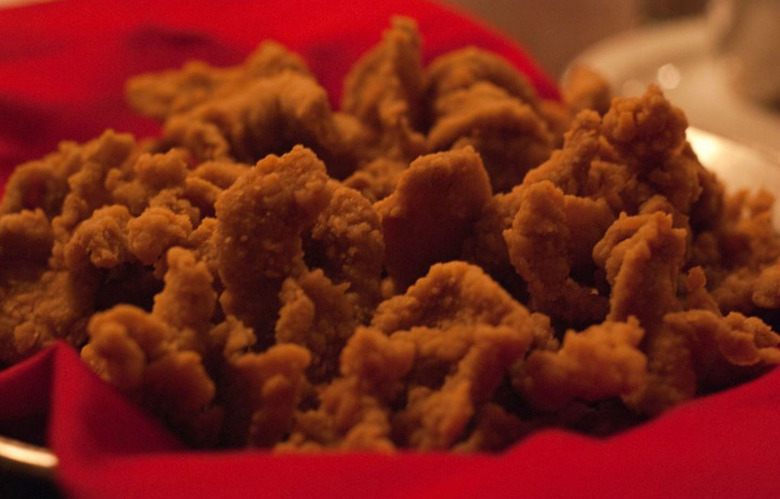Sweetbreads, Prairie Oysters, And 9 Other Bizarre Foods That Aren't What They Sound Like
Foods are under no obligation to have a name that makes any sense. For every spaghetti and meatballs out there, there's also Welsh rarebit, whoopie pies, and country captain. Some food names are pretty self-explanatory, but others are serious head-scratchers. And not only that, for some confusingly named dishes, the actual food is one that... Well, let's just say that it would be right at home on Andrew Zimmern's Bizarre Foods. Here are 11 foods that really aren't what they sound like.
Sweetbreads
Sweetbreads are decidedly not what they sound like. This delicacy is actually either the thymus or pancreas of a calf or veal, and it's known for its soft texture and mild taste.
Prairie Oysters
You won't find many oysters on the prairie, which should be the first sign that prairie oysters aren't what they seem. In reality, a prairie oyster is a raw egg cracked into a glass and topped with Worcestershire sauce, Tabasco, salt, and pepper, and drunk down in one shot. We hear it's good for hangovers!
Rocky Mountain Oysters
Also not exactly oysters, Rocky Mountain oysters are calves testicles, thin-sliced and deep-fried.
Lamb Fries
Don't let Burger King's Chicken Fries lead you to thinking that the name of this dish is literal; just like Rocky Mountain oysters, these are also thin-sliced and fried testicles, except from lambs instead of calves.
Milt
"Milt" is a rather benign name for a food that's anything but. Also called soft roe, it's... Well, let's just call it the male equivalent of roe and leave it at that.
Thousand Year-Old Egg
Also called century egg, preserved egg, hundred year egg, or pidan, this is one of the oddest egg treatments you'll ever encounter, but it doesn't actually take a thousand (or a hundred) years to make it. Eggs are preserved in a mixture of ash, clay, salt, quicklime, and rice hulls for up to several months, and at the end of the process the white becomes a translucent, salty brownish jelly, and the yolk dark green and creamy with a strong ammonia smell. Not for the faint of heart.
Head Cheese
Well, half of this name is accurate: It's made by taking all of the meat from the head of a calf or pig and forming it into a terrine with gelatin. No cheese required.
Sea Cucumber
Sea cucumbers aren't vegetables, even though they might look like one. They're actually a type of marine animal called an echinoderm, related to sea urchins and starfish. Considered a delicacy in parts of Asia, they're served in a wide variety of dishes and have a slippery texture.
Black Pudding
While it is black, this popular U.K. dish may not be what you think of as "pudding." In fact, it's more of a sausage, made with oatmeal or barley, pork or beef fat, and plenty of beef blood, from where it gets its black color. It's a common component of an English breakfast.
Chitterlings
Also spelled and pronounced chitlins, chitterlings are made by cleaning and cooking the small intestines of a pig. In the South, they're usually slow-cooked for a very long time before being battered and fried, and if not cleaned properly they can be all kinds of bad news.
Bombay Duck
Bombay duck isn't a duck at all; in fact, it's another name for lizardfish, which is usually dried and salted, or fried when fresh. It's most popular in parts of India.
Geoduck
Also bearing no relation to duck, geoduck (pronounced "gooey-duck") is a very large clam with a large, edible siphon. Eaten almost exclusively in parts of Asia, it's usually listed on sushi menus as "giant clam," and when raw and thin-sliced it has a slightly crunchy texture.
